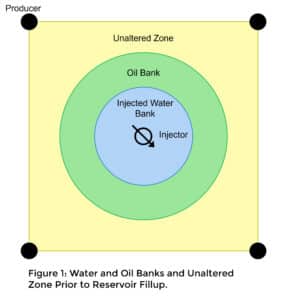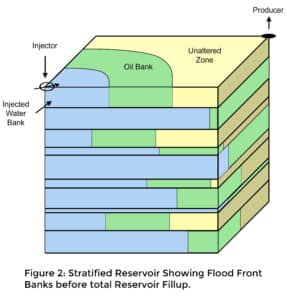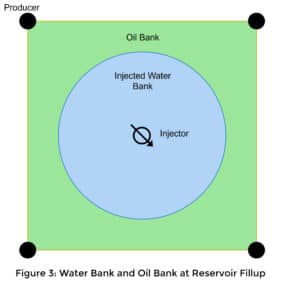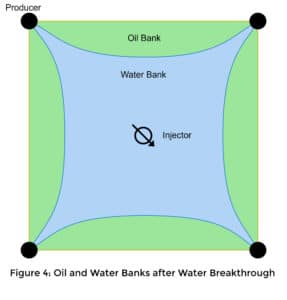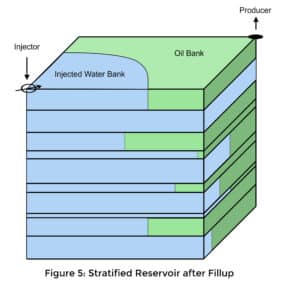Waterflooding Technical Courses and Training
Scoping Hidden Oil Potential in Mature Waterfloods
The Power of Volumetric Sweep Efficiency
Identifying remaining oil reserves in mature waterfloods can be difficult. Incomplete or unreliable injection and production records often hinder traditional analyses. This poses a challenge for engineers, geologists, and investors seeking to assess future recovery potential and economic viability. Volumetric sweep efficiency offers a helpful way to identify what oil is still available in a field or reservoir.
Work done by William Cobb and Frank “Deacon” Marek of Haas & Cobb Petroleum Consultants — developed a practical method to estimate volumetric sweep efficiency using only oil production data. By integrating this approach with decline curve analysis, operators can forecast ultimate sweep efficiency and quantify additional recovery potential. These insights help inform decisions on operational changes—such as infill drilling or pattern realignment—to improve efficiency and maximize economic returns. Read on for a deeper understanding of Volumetric Sweep Efficiency, and how it works.
Volumetric Sweep Efficiency—A Practical Overview
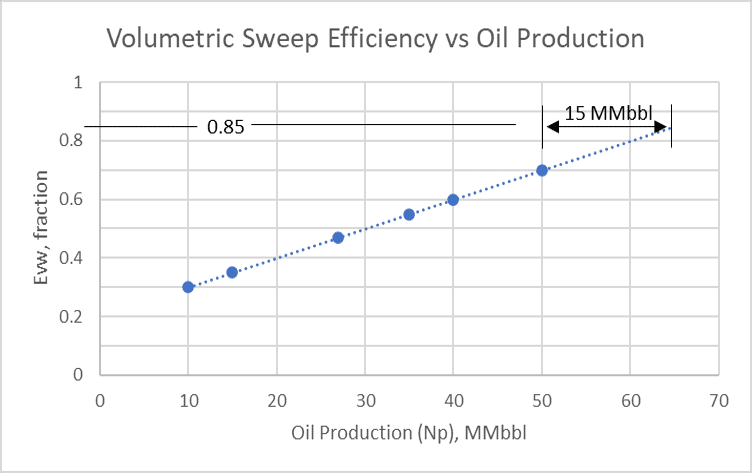 Volumetric Sweep Efficiency measures how effectively an injected fluid, such as water, displaces the original reservoir fluid, oil. It accounts for both areal and vertical sweep efficiency. Under the assumptions of piston-like displacement and minimal changes in formation volume factor during the waterflood, volumetric sweep efficiency can be expressed as a linear function of oil production.
Volumetric Sweep Efficiency measures how effectively an injected fluid, such as water, displaces the original reservoir fluid, oil. It accounts for both areal and vertical sweep efficiency. Under the assumptions of piston-like displacement and minimal changes in formation volume factor during the waterflood, volumetric sweep efficiency can be expressed as a linear function of oil production.
Simulation models of a typical field with a well-managed waterflood suggest that ultimate volumetric sweep may be as high as 85%, or higher.
By comparing estimated volumetric sweep efficiency to an 85% ultimate sweep, the remaining recoverable oil can be determined, helping assess whether further study or testing is warranted.
How It Works: The Detailed Approach
Before introducing the details of this technique, consider what happens in a reservoir before and during a waterflood. Waterfloods are often initiated when the reservoir pressure is below the bubble point pressure. The oil, gas, and connate water saturations at the start of injection are denoted by So, Sg, and Swc with a relationship of:
The fluid region surrounding the injection well is referred to as the Water Bank. The Oil Bank is a high-saturation, high-mobility oil region ahead of the waterflood front, driven toward production wells. The region adjacent to the producing wells has not been affected by the waterflood and is below bubble point. This region is called the Unaltered Zone. Figure 1 shows the waterflood saturation zones in areal view when part of the reservoir is still below bubble point or prior to “Reservoir Fillup”. In this work, Reservoir Fillup is defined as a period of stable producing GOR following an initial decline from a higher GOR prior to, or early in the waterflood project. Reservoir Fillup is achieved when the leading edge of the oil bank reaches the producing well.
Figure 2 shows the reservoir in three dimensions highlighting the vertical heterogeneity of the reservoir.
Note that in Figure 2, certain layers have reached Reservoir Fillup, while reservoir, as a whole, has not. As the oil and water banks continue to move through the reservoir, a declining producing gas-oil ratio (GOR) is observed. With continued injection, Reservoir Fillup will occur in all significant layers possessing permeability and porosity values greater than relevant net pay cutoffs.
At Reservoir Fillup, the GOR stabilizes, and free gas volume is considered negligible. The oil saturation in the oil bank is one minus the connate water saturation, So = 1 – Swc. Figure 3 shows the areal view of the reservoir after Reservoir Fillup and prior to water breakthrough.
Eventually, water will breakthrough at the producing wells, as shown in Figure 4.
Figure 5 illustrates that water breakthrough can occur in some layers but not in all at the same time, due to the heterogeneity of the different stratigraphic intervals within the reservoir. Figure 4 and 5 both highlight reservoir sweep inefficiency (areal and vertical, respectively). When water breakthrough occurs, there is remaining unswept oil within the various reservoir layers.
The volumetric sweep efficiency technique described here assumes that Reservoir Fillup has been achieved in all layers and there is negligible free gas in the system. With these assumptions, the cumulative oil produced from a waterflood since the start of initial injection is denoted as Np, where:
Np = oil in place at the start of waterflood – oil currently in the reservoir
And:
After Reservoir Fillup, the current remaining oil in place = oil in Water Bank + oil in Oil Bank
And:
Therefore,

Next, simplify and solve for Volumetric Sweep Efficiency, fraction (Evw):

Since,

Substitute Sg for 1 – So – Swc results in:

Where using the assumptions of a constant Sw, assuming piston-like displacement, and negligible changes to Bo, we have a linear relationship between Evw and Np.
The results of Evw versus Np can be plotted and can be used to solve for Np at an Evw of 85%, the estimated achievable volumetric sweep efficiency of a well-managed project in a typical field based on simulation model studies.
The difference between Np estimated at Evw=85% and the current Np suggests the remaining recoverable oil. An estimate of remaining recoverable can support the decision to pursue addition study or testing for bypassed pay.
Nomenclature
Evw = volumetric sweep efficiency, fraction
Sg = free gas saturation, fraction
So = oil saturation, fraction
“S” ̅w = water saturation behind the flood front, fraction
Swc = connate water saturation at the start of the waterflood, fraction
Bo = oil formation volume factor at the start of water injection, Rb/STB
*This value is assumed to be constant during the life of the waterflood.
Vp = floodable pore volume, barrels
Np = oil production, barrels
Closing:
Using volumetric sweep efficiency to scope potential oil recovery from aging waterflood wells can focus your team and result in greater recovery in the economic life of your waterflood project. Contact Haas & Cobb to discuss your specific waterflood project and if volumetric sweep efficiency might be beneficial for your team.


